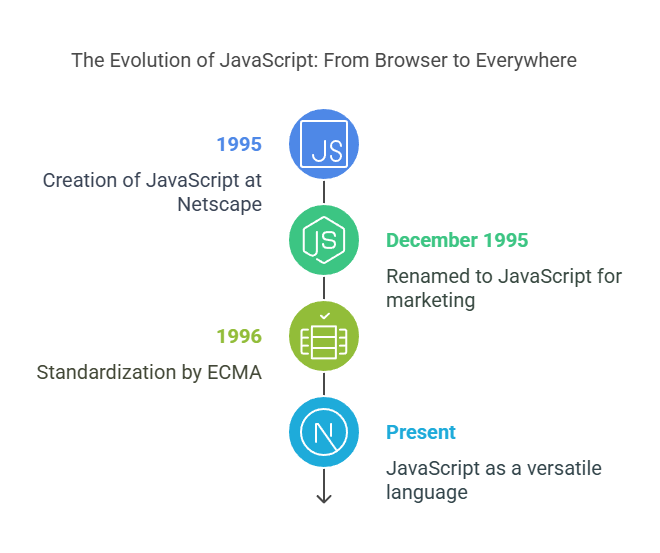The History Of JavaScript

JavaScript is popular for web development. It is now frequently regarded as the most popular programming language and a necessary ability for contemporary web development. JavaScript is frequently shortened to JS.
JavaScript’s beginnings started at Netscape in 1995. In specifically, it was designed to “make web pages alive” in the Netscape Navigator browser. Scripts are programs written in this language. They can be incorporated straight into the HTML of a webpage and will execute instantly when the page loaded.
JavaScript was created by Netscape Communications Corporation developer Brendan Eich. Some claim that Eich wrote JavaScript in as little as ten days, which is record time. It developed extremely quickly in the beginning. Some intriguing oddities or errors in the language’s design were also brought about by this haste to market.
Early on, the language went under a number of names. Mocha was its code name. LiveScript appeared in September 1995 Netscape Navigator 2.0 betas. JavaScript was renamed in December 1995 Netscape Navigator 2.0 beta 3.
To capitalise on Java’s fame, it was renamed “JavaScript” for marketing. JavaScript is commonly confused with “Java lite” or Java. JavaScript and Java are conceptually and design-wise different languages. JavaScript shares more similarities with languages like Self and Scheme, even though it does borrow some syntax from Java.
Microsoft swiftly reverse-engineered JavaScript when Netscape debuted it, introducing an exact replica known as Jscript in Internet Explorer to circumvent trademark concerns.
JavaScript’s original purpose was to glue together Java-implemented client-side web features and make HTML more interactive. JavaScript has to appear like Java to assist Java, ruling out Perl, Python, and TCL.
ECMA helped standardise JavaScript in 1996. Due to trademark concerns with the term “JavaScript,” the language’s standardised version was dubbed ECMAScript. Despite being technically distinct, practically everyone refers to the language as JavaScript in everyday situations. The specification is now called ECMAScript, and the language is JavaScript.
As browsers evolve, JavaScript comes in many versions, and older browsers are incompatible with the latest versions. The TC39 procedure keeps the standard evolving.
Browsers were merely web page readers in the early days of the internet, capable of nothing more than showing text. The notion that browsers could do practical tasks on their own surfaced. JavaScript was created to give HTML pages more interaction. It functions in tandem with HTML, which establishes the content of the page, and CSS, which establishes the layout. JavaScript and CSS generate DHTML pages.
JavaScript code runs without compilation in HTML pages. Because it is an interpreted language, an interpreter or engine runs its code line by line during runtime. The interpreter or “JavaScript virtual machine” are other names for the “engine” that comprehends JavaScript. Chrome, Opera, Edge, and Firefox have codenames like V8 and SpiderMonkey.
JavaScript’s early effects included flickering mouse trails, irritating pop-up prompts, and spinning logos. At first, there was no API for working with a document that had already been rendered. JavaScript could only modify content if it was created dynamically using the document while it was loading.use the write() method. Prior to the DOM, the Netscape 2 web browser implemented this technique as one of the first scriptable APIs.
Programmers used to dislike JavaScript because it was slow when it ran in web browsers. In the past, there have been problems with JavaScript functioning differently in various browsers. But because browser manufacturers chose to accept the standardised version long ago, JavaScript is now supported by all major browsers. Modern JavaScript code operates significantly quicker than compiled code-up to 80% faster and keeps getting faster. With its ability to create rich online apps that behave and seem like native desktop applications, it has developed into a powerful and effective general-purpose language that is appropriate for professional software creation.
Nowadays, practically all websites make use of JavaScript. It can run not only in the browser but also on the server (like Node.js) or any device with a JavaScript engine, and it has made its way into a number of other domains, including databases, wearable technology, and smartphone apps. JavaScript, which is fully integrated and optimised for browsers, is currently the only language that can run natively in browsers. JavaScript programmers are in demand and expanding.
